Techno, Tacos, and Traffic – 12 Reasons Why MUTEK.MX 2013 Was an Unforgettable Event
It’s no secret that XLR8R has a lot of love for MUTEK. For the past […]
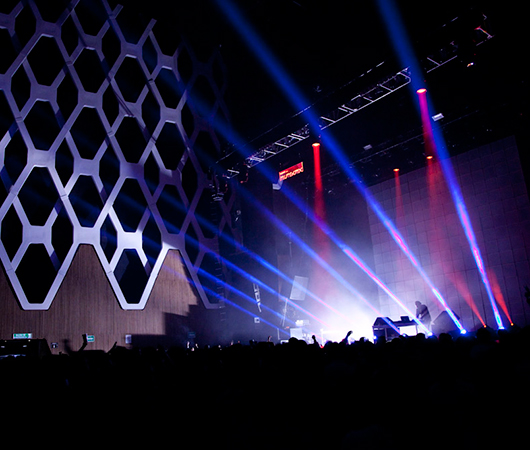
Techno, Tacos, and Traffic – 12 Reasons Why MUTEK.MX 2013 Was an Unforgettable Event
It’s no secret that XLR8R has a lot of love for MUTEK. For the past […]

It’s no secret that XLR8R has a lot of love for MUTEK. For the past 15 years, the Montreal-based organization has been combining a love of electronic music with a passion for technology and visual art, and somehow only seems to be getting better with age. This year’s MUTEK festival in Montreal was undoubtedly one of 2013’s best events—our review has plenty of details that explain why—so we were admittedly excited when the organization’s Mexican wing once again invited us to Mexico City to check out what a different branch of the crew had to offer. After all, the 2012 edition of MUTEK.MX was certainly enjoyable, and this year actually marked the 10th anniversary of the organization’s activities in the Mexican capital. Given that, our expectations were high, and it would have been easy for the festival to fall short of them, particularly when one factors in the complexities of putting on this type of event in Mexico City. Nevertheless, after a decade of doing this, it appears that the the MUTEK.MX crew has learned how to run a relatively tight ship. The festival may not have gone off without a single hitch, but after spending an entire week in Mexico City and attending a myriad of events, we would be lying if we said that we had anything but a wonderful time.
The Field (photo by Elizabeth Cacho)
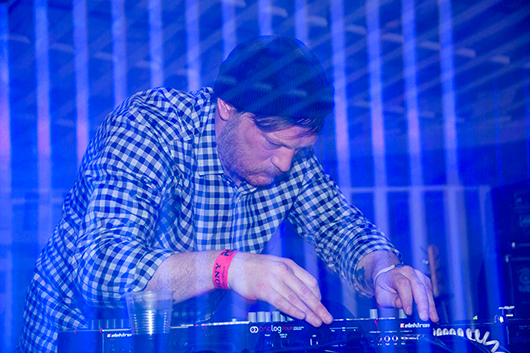
Mexico City is an incredible place.
XLR8R has done a lot of traveling on the festival circuit this year, and while our enjoyment of a festival ultimately boils down to the quality of music on offer, it would be disingenuous to act as though an event’s setting and location doesn’t factor into the equation. Simply put, Mexico City is amazing. Referred to locally as DF, it’s a sprawling mass whose greater metropolitan area is home to more than 20 million people. In short, it’s massive, with a landscape that looks something like a warped version of Los Angeles, particularly with its streets that are seemingly choked with traffic—and adventurous drivers—around the clock. However, where Angelenos are famous for their refusal to walk even a few blocks, we found the sidewalks and streets of DF to be absolutely teeming with activity; every block was stuffed with commuters, tourists, street vendors, makeshift food stands, and more. That said, even though people were everywhere and quiet was in extremely short supply, Mexico City appeared to take it all in stride; the constant hustle and bustle seemed to be accepted as merely another part of life in DF, which is perhaps why being Mexico City didn’t bring the same stress as being in, say, New York or other similarly active locales.
The lack of intense geographic concentration is undoubtedly part of what kept our claustrophobia under control in DF, but there was more to it than that. Despite all the chaos, greenery and parks littered the landscape, particularly in trendier neighborhoods like Condesa and Colonia Roma, where we admittedly spent a lot of our time. Walking around those areas and other parts of the city, it was hard not to be taken in by the architecture. It’s not that every building was amazing—in truth, many structures were decidedly not—but the juxtapositions were fascinating. One could find a Spanish-style house next to a tony loft complex next to an art-deco building, and somehow, it all fit within a sort of bizarre logic that appeared to define DF. The city was full of hybrids, and this collision of cultures, classes, politics, ideas, and ways of life seemed to breed a real sense of vitality. For all of its history and traditions, Mexico City felt genuinely fluid and open; granted, our view was undoubtedly tainted by spending a week surrounded by MUTEK and its devotees, but the fact that a forward-thinking event like this could flourish for a decade in DF speaks volumes about where the city’s head—and heart—are at.
Ikonika (photo by Elizabeth Cacho)
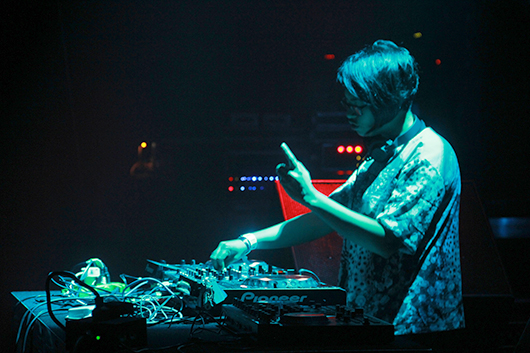
The MUTEK.MX crowds were young, excited, and hungry for more.
As much as we love MUTEK’s flagship festival in Montreal, it’s no exaggeration to say that the event generally attracts an older crowd. In much of North America, the market for thoughtful, intelligent electronic music and the intersection of art and technology is usually not one heavily populated by the more youthful sectors of the music world. That being said, it seems that Mexico City didn’t get the memo; not only were the numerous MUTEK.MX events stuffed to the brim with attendees, those attendees were young, enthusiastic, and ready to party. That may sound a bit alarming for the beard-stroking set, but it was invigorating to see young people coming out in droves for music that was both underground and required a real sense of patience to enjoy. For instance, German trio Brandt Brauer Frick performed on Wednesday night with an ensemble (including a violinist, harpist, cellist, tuba player, trombone player, and two percussionists) at the stunning Teatro de la Ciudad, a gorgeous, multi-level venue in the historic city center. Obviously, Brandt Brauer Frick isn’t an outfit known for its “bangers,” and the setting wasn’t exactly ripe for a raucous party, but that didn’t prevent the show from selling out and the seats from being filled with visibly excited young people. Seeing drove of teenagers clamoring for tickets as we entered the venue was a real surprise, and something that we doubt would have happened a similar event in the United States or Europe.
This was just a single example, but this sense of enthusiasm permeated the entire week, from MUTEK’s lectures and symposiums during the day to its numerous parties at night. Admittedly, some of this energy undoubtedly stemmed from the sheer novelty of an event like MUTEK in Mexico City. Despite MUTEK.MX’s decade-long history, it’s not every day that line-ups and events of this caliber and musical bent take place in the Mexican capital, which meant that sheer curiosity likely prompted some festivalgoers to check out a show or two. Still, regardless of their motives for walking through the door, the MUTEK.MX crowd was refreshingly free of cynicism; the “been there, done that” attitude that colors similar events in the US and Europe was essentially absent. Basically, people at MUTEK.MX were visibly happy to be there, which only boosted our own enjoyment of the festivities.
Mount Kimbie (photo by Isla Kriss)
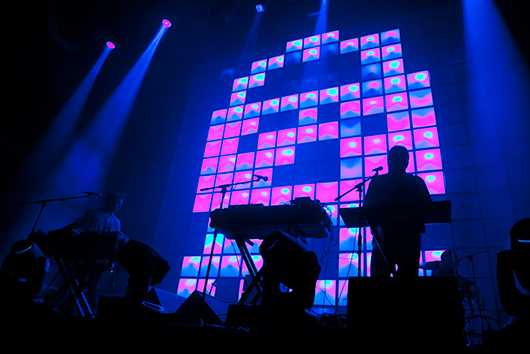
When it came to visuals and venues, MUTEK.MX was truly stellar.
When it comes to festivals, XLR8R tends to favor events that keep things small; after all, electronic music is generally consumed in a club environment, so that’s how we usually like to hear it, even when the line-up is stacked with world-class talent. However, the problem with club-based festivals is that they’re often stuck with whatever venues their city has. Maintaining quality and creating a consistent vibe across multiple nights and venues is no easy task, particularly when those venues are owned and operated by distinct parties with wildly different agendas that rarely coincide with what the festival is trying to accomplish. No one wants a club-based festival to merely feel like a collection of shows that are only tied together by the wristband required for entry, but avoiding that pitfall requires an effort—and a budget—that goes above and beyond the norm. It’s a tall order, but MUTEK.MX was unquestionably up to the task this year. The week’s regimen of shows featured a wide range of venues, but whether something was happening at a small cantina, like the charming, bullfighting-themed La Faena, or a massive spot that was still under construction, like the raw, unfinished Foto Museo Cuatro Caminos, MUTEK organizers did their part to make things feel special. It helped that the locales selected were clearly impressive to begin with, but MUTEK.MX augmented them all with sleek design and decor, beefed-up sound, and impressive visuals.
Of course, all of the week’s shows involved some sort of visual component, which has always been an essential part of the MUTEK formula. Like its Montreal counterpart, MUTEK.MX includes an audio-visual series in its program—in Mexico, it’s been dubbed A/Visión—and these shows obviously sought to focus on the visual element. While the festival’s closing night, an A/Visión presentation of Amon Tobin‘s ISAM show, left plenty of jaws agape, some of the most memorable A/Visión moments happened on Saturday evening at the Teatro de la Ciudad, when UK duo Raime combined its punishing, starkly cinematic soundscapes with intense, slow-motion visuals and were followed by the goofy experimentalists of Matmos, who paired alternately silly and psychedelic imagery with their whimsical sound experiments.
Raime (photo by Elizabeth Cacho)
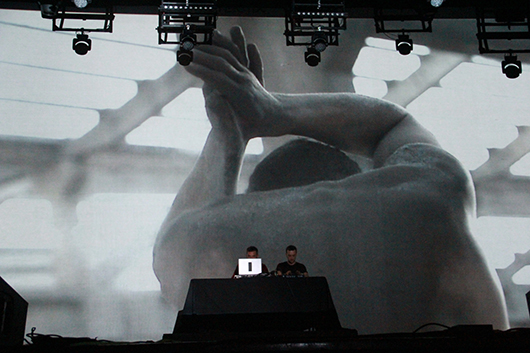
However, the week’s most impressive visuals happened on Friday and Saturday night during MUTEK.MX’s Nocturno shows. Friday’s event—which was actually co-branded as an A/Visión showcase—took place at the aforementioned Foto Museo Cuatro Caminos, which featured two rooms with very different vibes. The main room was more polished, and played host to an excellent audio-visual set from Diamond Version, the collaborative project of Raster-Noton founders Alva Noto and Byetone, along with more standard performances from the likes of James Holden, Saschienne, The Field, and Actress. The sound in the room was booming, and the stage was backed by two giant screens, which kept an interesting array of abstract, brightly colored visuals coming throughout the evening. Less impressive was the second room, as it was hampered by some major sound issues for much of the night—which noticeably detracted from sets by Delorean and Barnt—but the visual aspect did shine once Machinedrum came on stage to deliver his newly debuted Vapor City Live show. Things were more consistent on Saturday, when the Nocturno series shifted to El Plaza Condesa. The venue as essentially one massive room with a vaulted ceiling, which wouldn’t have been anything particularly special were it not for the massive LED screen that was erected behind the stage. Throughout the night, performances by the likes of FaltyDL, Mount Kimbie, Ikonika, Kode9, and JETS were backed by a combination of this brightly colored grid with a series of equally colorful projections. Together, it created a retro-futuristic effect that looked like a mix between some sort of puzzle-based videogame (think Tetris) and the neon-streaked skylines of a place like Tokyo. It’s usually pretty easy for visuals to be filed into the “whatever” category, but Saturday night’s visual display was honestly quite dazzling.
Jets (photo by Isla Kriss)
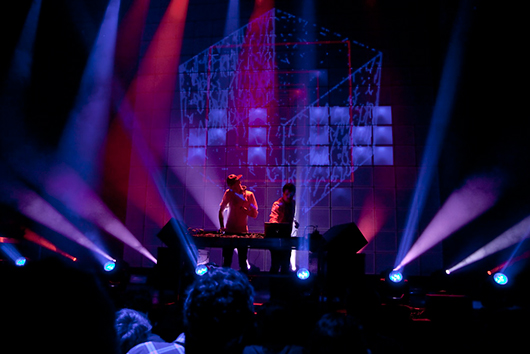
MUTEK.MX’s pace and programming were similarly on point.
There’s little question that today’s festival market is oversaturated, which often leads organizers to attempt to haphazardly cram as many acts as possible into their events. What often results are bloated, multi-stage, multi-day festivals where giant crowds are herded into massive spaces and subjected to line-ups that often have little coherence from one act to the next. While a handful of events have managed to attain creative success with this model, XLR8R tends to favor events whose curation is guided by an actual point of view, and MUTEK.MX undoubtedly fell into that category. Given the MUTEK branding, there was little doubt that the music was going to be good; nevertheless, it bears mentioning that although MUTEK is most closely associated with techno, organizers have branched out considerably in recent years, and now put together line-ups with innovative artists from across the electronic and experimental spectrum. Many of this year’s most intriguing artists have already been mentioned, but organizers should also be credited for involving a number of Mexican artists, including several acts from DF itself. While it would have been nice to see a few more Mexican acts on the bill, or for those who were tapped to be given some better timeslots at the weekend’s biggest shows, MUTEK.MX did a solid job overall in terms of building a line-up that balanced the festival’s creative goals with actual audience appeal.
Speaking of scheduling, MUTEK.MX perhaps deserves the most credit for the relatively relaxed agenda it presented throughout the week. While there was plenty of activity on offer, festivalgoers were rarely forced to choose between simultaneous events. Most nights featured only one major event, which not only gave attendees plenty of down time to enjoy the city, but also eliminated the stress of scrambling from one venue to another or having to make hard choices about which artists to skip. Even after going out every night for a week straight, once MUTEK.MX came to a close, we found ourselves significantly less ragged than we expected. The old adage “less is more” may be a cliché, but in the case of this year’s MUTEK.MX, it was entirely accurate.
Matmos (photo by Elizabeth Cacho)
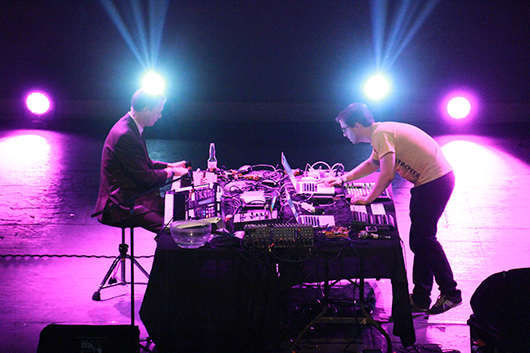
The food was insanely good.
Allow us to apologize right off the bat for being a bit un-journalistic here, but…
HOLY SHIT THE FOOD IN MEXICO CITY WAS UNREAL!!!
XLR8R rarely takes the opportunity to talk in depth about food, but in the case of MUTEK.MX—or any trip to Mexico City—the cuisine was an essential part of the experience. Without exaggerating, we can honestly say that delicious food was everywhere; better yet, it came in all shapes and sizes. Tacos were obviously a huge part of the equation (at least for us), but that was just the tip of the iceberg. Mexican food is so incredibly varied and incorporates so many different influences and regions that trying to boil it down is an almost impossible task. Given that, we could go on and on about the amazing things we ate (and truthfully, just about everyone who came from outside of DF for MUTEK.MX couldn’t shut up about the food), but allow us to simply say that the food was incredible, whether it was being served at a stand on the street or at a trendy sit-down restaurant. The festival may have satisfied our ears, eyes, and brains, but DF’s next-level food culture made sure that we also maintained full—and very happy—bellies throughout the week.
Kode9 (photo by Elizabeth Cacho)
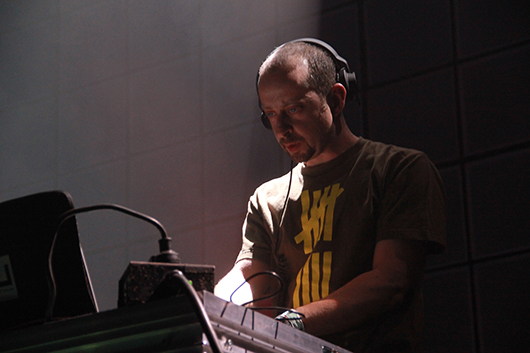
Kode9’s combination of gully sounds from both sides of the Atlantic pushed all the right buttons.
Over the past few years, Hyperdub boss Kode9 has been heavily active on the DJ circuit, and during that time, he’s developed a unique musical voice that is perhaps the best representation of the current cross-pollination between dance music from the UK and the US. The man clearly has a thorough understanding of his homeland’s so-called hardcore continuum, which enables him to nimbly jump between choice cuts of grime, garage, bassline, jungle, and bass music, but he’s also dug deep into the varied urban (or “ghetto”) sounds coming out of the US, most notably juke/footwork, R&B, and hip-hop. On Saturday night at MUTEK.MX, he brought all of these styles together beautifully. Rarely allowing a song to play for more than a couple of minutes, his set bounced between genres with a sort of reckless abandon, but his superb mixing prevented things from ever getting too far out of control. More importantly, Kode9 appeared to understand which dots connect all of these sounds and styles, which enabled him to make transitions cleanly, both on a technical and musical level. Watching him work was truly impressive, as he not only maintained a high energy level—the crowd was visibly pumped throughout his set—but also a flow that felt entirely natural. In the wrong hands, this kind of set could have easily dissolved into a mess, but Kode9 proved that he is one of a select few DJs who can ably maintain a party vibe while serving up something that’s wholly intelligent.
A/Visión 3 – Nocturno 1; main room at Foto Museo Cuatro Caminos
(photo by Elizabeth Cacho)
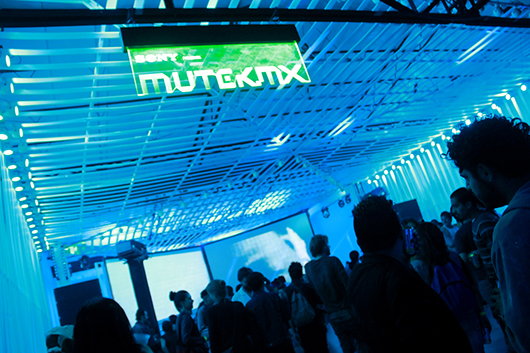
Ñaka Ñaka headed up a promising crop of Mexican talent.
Throughout the week, a smattering of Mexican talent performed at MUTEK.MX, and some of the acts were quite good. HDXD kicked off Tuesday night’s opening party with a noisy brand of witch-house that was admittedly a little undercooked, but the duo won major points for its fluorescent flourishes and artsy costume design. Tijuana producer Machino also showed some flashes of excellence during his lengthy, house-oriented set on Thursday night at Faena. But of all the Mexican artists we saw, Ñaka Ñaka was by far the best. The unassuming producer hails from Mexico City, but actually resides in Brooklyn these days, and though he could be lumped in with his adopted home’s current fascination with noisy techno, his music has a lot more in common with what’s happening in Berlin. Ñaka Ñaka’s set quite literally found him sitting down behind a laptop, but the music was centered around a slow-burning, dark, and droney take on Berghain-style techno. Segueing between foreboding beatless interludes and hard-charging rhythmic assaults, Ñaka Ñaka showed a lot of promise, and is certainly someone we’ll be keeping tabs on in the months ahead.
James Holden (photo by Elizabeth Cacho)
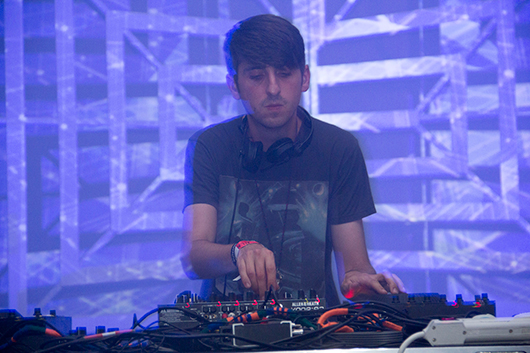
The MUTEK.MX crowd was psyched for James Holden, and he didn’t disappoint.
We’re not sure exactly how James Holden became so big in Mexico, but there was a palpable excitement in the air during the hours leading up to his headlining appearance on Friday night at the Foto Museo Cuatro Caminos. His set actually began 40 minutes later than it was originally scheduled—the main room was running behind the entire night—but the delay did nothing to dampen the crowd’s spirit. Though Holden is often hailed as one of the few artists who can dabble in trance without descending into total cheese, his music runs much deeper than that. His productions are impeccably detailed, and he takes a similar approach when he’s DJing, combining complex, multilayered tracks into a greater whole. At MUTEK.MX, the first 20 minutes of his set were especially captivating, as he kept things loose while warming up the floor with jazzy rhythms, Krautrock-esque melodies, and, at one point, an African vocal. It was an entrancing start, and primed the crowd for the more pounding material that followed. Though Holden never descended into a full-on techno assault and generally kept things melodic, the beats were pumping and the music sounded great. There was a real richness to his selections, so the set came across as more than just a simple procession of tracks. Texture and color were at the forefront, and it was easy to get lost in the musical tapestry that Holden put together.
Frikstailers (photo by Marc van der Aa)
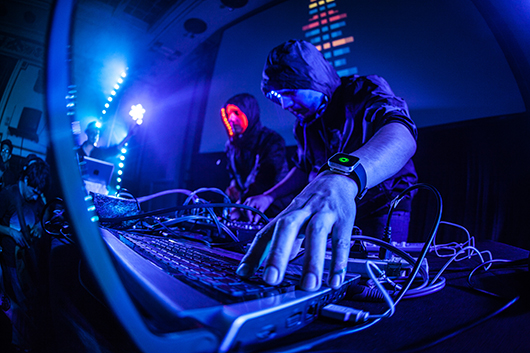
The Frikstailers unveiled a new show, an updated sound, and a reinvigorated sense of purpose.
Argentinian duo Frikstailers is an outfit that we’ve been tracking for some time, as the pair first came to prominence in the late ’00s as part of the ZZK crew and the general wave of excitement surrounding cumbia digital and other forms of what eventually came to be known as tropical bass. While tastemakers’ interest in those sounds has waned in recent years, the Frikstailers always seemed particularly poised to transcend the hype. Cumbia and other tropical rhythms were undoubtedly a part of the duo’s arsenal, but there was also a lot inventive beatwork and creative impulses that took notes from across the electronic spectrum. (The duo’s affinity for colors, masks, and bizarre wigs was also a unique touch.) A couple of years ago, Frikstailers relocated to Mexico City, and the outfit has since continued to refine its sound.
At MUTEK.MX 2013, the pair elected to take that process a step further, and assembled a new show called “Klik & Frik.” Though the group took the stage for its headlining set on Thursday night at La Faena nearly an hour late—this was another show that ran behind—within moments, the crowd was bouncing with an energy level the dancefloor hadn’t seen all night. As expected, most of the tempos were in the “tropical” range between 90 and 105 bpm, but the sounds employed were not from what most would consider the standard Latin or tropical playbook. Instead, Frikstailers injected those rhythmic structures with sounds more often associated with house and techno. Although this idea isn’t exactly new, and has occasionally proven to be less than satisfying (see: most moombahton), in the Frikstailers’ hands, the results were absolutely compelling. The beats may have been slower than most house and techno, but the Frikstailers’ knowledge of tropical rhythm structures—not to mention the seemingly inherent energy within many of those genres—allowed the duo to offer up music that was lively, upbeat, and fun. (Speaking of fun, the pair’s costumes, which were less over the top than before, still involved matching hoodies adorned with LEDs, and undoubtedly helped to keep things from getting overly serious.) Over the course of the Frikstailers’ hour-long set, we were often reminded of the vaguely tropical and Balearic sounds of John Talabot’s Hivern Discs label, although the Frikstailers’ tunes were certainly a bit more manic. Regardless, it was great to see the pair taking a creative step forward without sacrificing all the things that made the group so enjoyable in the first place.
Machinedrum (photo by Elizabeth Cacho)
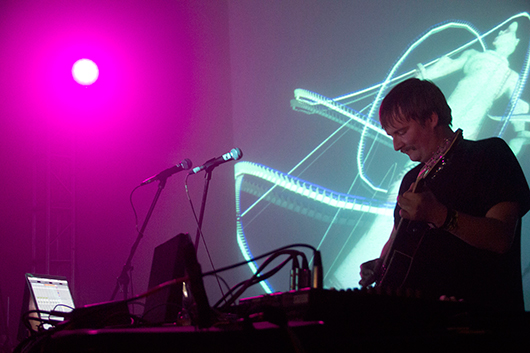
Machinedrum’s second go-round with Vapor City Live was maybe even better than the first.
A couple of weeks ago, we were lucky enough to catch the debut performance of Machinedrum’s new Vapor City Live show at the Decibel Festival in Seattle—our review of that festival is here—which, despite one major hitch (the failure of the visuals about 20 minutes into the set), we thoroughly enjoyed. Nevertheless, we were still a bit concerned in the hours leading up to the Berlin-based producer’s appearance on Friday night at MUTEK.MX, not because we doubted Machinedrum’s talents, but because the room he was scheduled to play in had been home to some less than spectacular sound all night long. However, our worries ultimately proved fruitless; while things were undeniably a little more reverb-heavy than everyone would have liked, Machinedrum’s sound engineer incredibly managed to right the ship, and the show sounded great. Even better, the visuals made it through the entire set, and added a compelling additional element to the proceedings. Overall though, it was the music that did the heavy lifting, and Machinedrum’s combination of juke and jungle rhythms with airy melodies, live percussion (provided by his on-stage partner Lane Barrington), and his own vocals kept the room packed and enthusiastic. With dozens more live shows lined up in the months ahead, it appears that Machinedrum has put himself in a good position to properly wow crowds around the globe.
Actress (photo by Elizabeth Cacho)
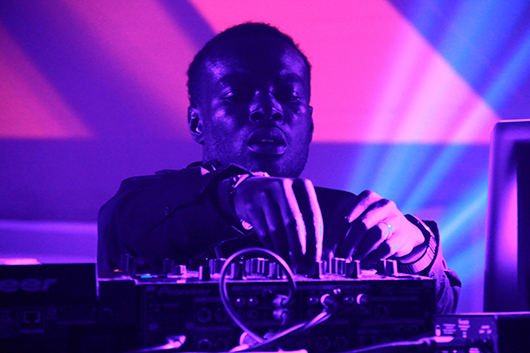
Diamond Version and Actress were ominously entertaining, albeit in very different ways.
Diamond Version and Actress held two of the early slots on Friday night in the main room of the Foto Museo Cuatro Caminos, and the two acts were greeted by big crowds anxious to see what they had in store. As it turned out, they both offered something that was dark and just a bit menacing, although they didn’t share much beyond that. Diamond Version has only a handful of singles to its name, but the duo appears poised to break big in the months ahead. Between the veteran pedigrees of Alva Noto and Byteone and the group’s combination of noisy techno with arresting visuals, Diamond Version is the sort of outfit that is almost certain to capture the hearts and minds of both music journalists and high-minded trend watchers when its debut LP surfaces early next year. That’s not meant to discredit Diamond Version or its music; regardless of whether or not what the pair is doing is fashionable, it’s without question rather good. AT MUTEK.MX, the duo infused a noise-techno template with frantic Detroit electro rhythms and even took cues from what sounded like classic rave tropes. Intense is a good way to describe Diamond Version’s performance, and though the duo didn’t exactly ease the crowd into the evening, we got the feeling that nobody seemed to mind.
Actress, on the other hand, certainly took his time before ratcheting up the intensity level. Coming on after Diamond Version, the first 20 minutes of the UK producer’s set were devoted to meandering synthscapes and beatless electronic exploration. Actress is known for being a bit erratic with his performances and switching things up wildly from one night to the next, so as his opening salvo streched longer and longer, a nervous energy began to take hold of the crowd. However, seemingly moments before he lost the room entirely, Actress delved into his unique brand of broken techno and warped house, which quickly reinvigorated the dancefloor. From that point on, he kept the rhythms coming, and by the end of his set, he was actually playing uncharacteristically bright and melodic house. It was just another example of how one can never know exactly what to expect from Actress, although we suspect that his unpredictably is an important component of what makes him such a compelling artist.
Diamond Version (photo by Elizabeth Cacho)

The MUTEK.MX crew deserves high praise.
Each year, XLR8R is lucky enough to attend a wide range of festivals around the globe, some of which are excellent, and some of which most definitely aren’t. Granted, throwing a festival anywhere is a difficult task, particularly one that’s almost entirely devoted to underground electronic and experimental sounds, but some events simply manage to rise above the rest. The 2013 edition of MUTEK.MX undoubtedly fell into that category, and scored all sorts of bonus points for managing to do it in Mexico City, a place that’s not only a bit of a logistical nightmare, but is also a city that’s not necessarily accustomed to having these kinds of festivals. Granted, the MUTEK.MX crew has been at this for a full decade, so it wasn’t much of a surprise that things like massive traffic jams and unexpected weekend rainstorms did little to gum up the works, but we were still thoroughly impressed with the festival and its organization. Apart from some scattered issues with sound and a few shows running behind, we found very little to take issue with throughout the week. More importantly, we found ourselves energized by the festival, not only because of the excellent assemblage of artists that took part, but also because of the enthusiastic response of those in the crowd. Festivals of this ilk often rely on the attendance of folks coming in from out of town to balance the books, but MUTEK.MX felt almost wholly local, which was a truly promising sign for a city which is often regarded as an afterthought within the electronic landscape. If MUTEK.MX can keep building in the years ahead—and hopefully inspire like-minded individuals and organizations to do the same—it’s not that difficult to envision DF as a full-fledged electronic hotspot. In the meantime, we’ll certainly be making a point to come back and check on the city’s progress as soon—and as often—as possible.

